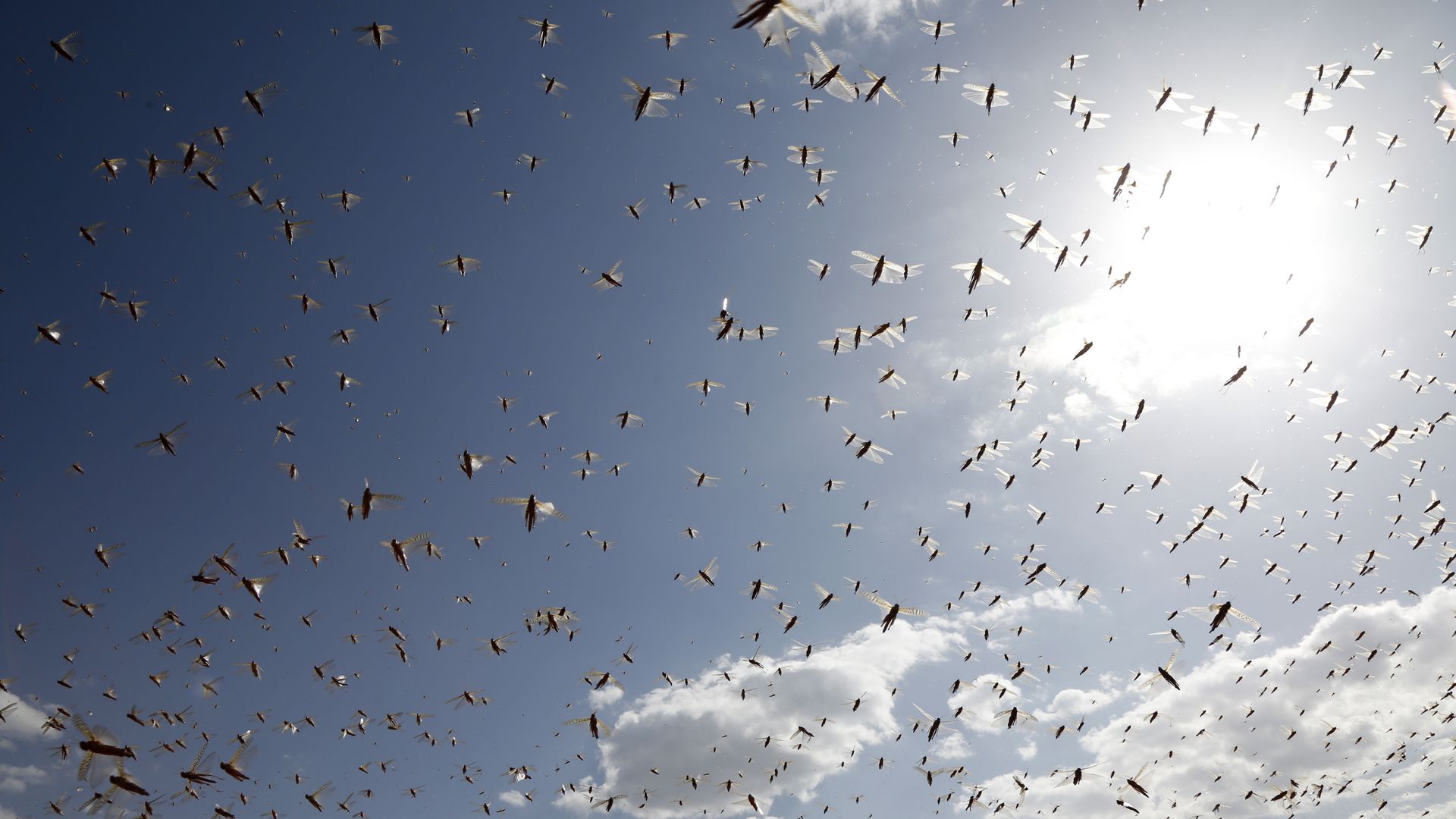A swarm of desert locusts in Dhamar province, Yemen, June 6, 2020. Photo: Mohammed Mohammed/Xinhua via Getty
A scent produced by migratory locusts triggers them to swarm — a newly discovered detail that could help efforts to stop the pests.
Why it matters: Swarming locusts can destroy crops and vegetation for livestock, wreaking havoc in their path.
- The largest outbreak of desert locusts in decades is ravaging East Africa this year, affecting hundreds of thousands of hectares of crops and putting an estimated 5 to 20 million people at risk of acute food insecurity.
How it works: Locusts, which are species of grasshoppers, are typically solitary insects. But under certain conditions — for example, heavy rains followed by abundant vegetation — they can enter a gregarious phase and form large swarms.
- A one-square kilometer swarm of desert locusts, Schistocerca gregaria, containing about 40 million insects can eat as much food in one day as 35,000 people.
- Pesticides, spread via plane or on the ground, are used to fight locusts, but they come with a catch: they can be hazardous to other insects and humans.
What’s new: In a series of experiments, Le Kang and colleagues at the Chinese Academy of Sciences identified a pheromone that attracts and aggregates migrating locusts (Locusta migratoria), a different species than desert locusts.
They found:
- The compound 4-vinylanisole (4VA) is emitted far more by gregarious locusts than solitary ones, and attracted both young and adult, and male and female, locusts — all of which swarm.
- Both solitary and gregarious locusts were attracted to the pheromone.
- Just four or five locusts are required to start the production of 4VA.
- When more locusts swarmed together, there was more of the pheromone in the air.
- And they used CRISPR-Cas9 gene editing to create locusts without the gene encoding for a receptor (OR35) in the insect’s antenna and found the mutant insects didn’t respond to the pheromone.
- Finally, the researchers placed traps containing 4VA in a field and found it attracted some locusts.
“This is a very exciting finding which advances our knowledge in the chemical communication system of locusts,” Baldwyn Torto, a scientist who studies locusts at the International Centre of Insect Physiology and Ecology in Nairobi, Kenya, tells Axios via email.
- In earlier work, Torto identified a derivative of 4AV in the “odor bouquet” of mature male desert locusts and he says there is evidence 4VA is produced by both sexes of mature desert locusts.
- Yes, but: Whether 4VA plays the same role in desert locust swarming is yet to be elucidated, says Torto. And it would be important to understand the role of other compounds in the behavior, he adds.
Context: Kenya, Pakistan, Yemen, China, Argentina, Russia and other countries on the African, Asian and South American continents battled desert locusts and other species of the pests over the past few months.
- An outbreak of desert locusts in northern Africa between 2003 and 2005 caused an estimated $2.5 billion in crop damage.
- The World Food Programme estimates “the cost of responding to the impact of locusts on food security alone to be at least 15 times higher than the cost of preventing the spread.”
What to watch: The authors of the study in the journal Nature suggest several ways the findings could help to create tools that specifically stop locusts.
- A compound that blocks the OR35 receptor could be identified and sprayed to prevent swarming, or synthetic 4VA could be used to trap locusts (though the range and efficiency would have to be improved).
- They also suggest mutant locusts without the 4VA receptor could be created and released to “establish non-gregarious locust populations for long-term population management, subject to biosecurity evaluation.”
- Such gene-drive experiments are being proposed to control mosquitoes and the spread of malaria, they are controversial because of their unknown ecological implications.
Source: Researchers find scent behind some devastating locust swarms













